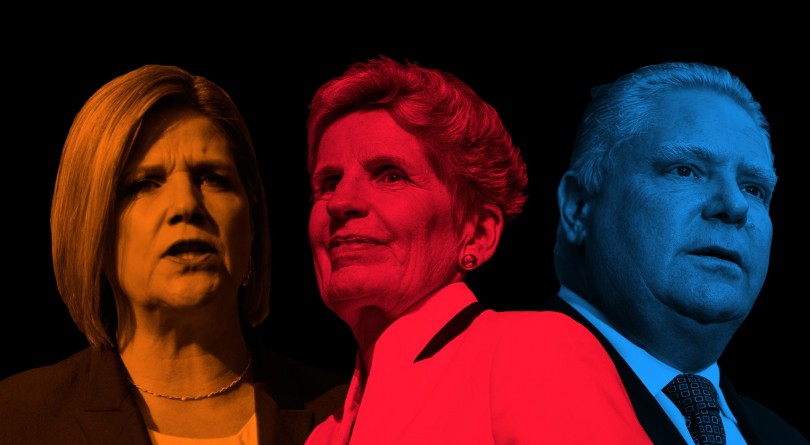
With only a few days to go until the Ontario provincial elections, Kathleen Wynne has announced that the Liberals won’t win, however she’s encouraging voters to vote Liberal in order to prevent the Progressive Conservatives and the New Democratic Party from forming a majority government. Between selling Hydro One, buying the Trans Mountain pipeline, and referring to Prime Minister Justin Trudeau as “Mr. Dressup,” it seems most Canadians are fed up with the Liberals and are ready for change.
Regardless of which political party one chooses to align themselves with, the importance of voting cannot be stressed enough. Most importantly, statistics show a disengagement between young voters and politics which poses a problem as the younger generation grows to become productive members of society. This disengagement is due to multiple factors such being unable to relate to politician’s platform, lack of knowledge, lack of trust to represent issues important to young people, and socio demographic factors such as education. There are many issues that hit close to home, affecting young people. The lack of job security, and the inability to secure permanent employment with benefits is a concern amongst many of us. This in turn makes it difficult to pay off student loans, secure a mortgage, and save up for retirement. The increasing cost of affordable child care is also off putting to many young individuals and couples who prefer to postpone marriage and starting a family. Exorbitant tuition fees for post secondary education, and strikes impact thousands of students who struggle to obtain higher education, and are swamped in debt which can take years to pay off. Climate change, a pressing issue that needs to be tackled in order to secure a sustainable future for those to come, and in turn the creation of greener cities opens up job opportunities for young adults.
The good news is, the 2015 federal elections saw an increase in young voters in comparison to the 2011 elections. In particular 57.1% of the 18-24 demographic voted in the 2015 election as opposed to 38.8% in 2011. After the Conservative Harper government, Justin Trudeau was a fresh face that young Canadians related to, and so flocked to the polls in high numbers. While the voter turnout rate for this groups is less than the Canadian average of 66.1%, the gap is narrowing as more young people gravitate towards an increased interest in politics.
On that note, let’s take a look at the three primary candidates vying for your votes and their stances on some of the major issues affecting young Canadians.
Education
The Liberal Party of Ontario promises to offer OSAP grants for low income students in order to cover tuition costs, $625 million towards funding education and $300 million to improve special education programs, and hope to provide free full daycare for pre schoolers starting in 2020.
The Progressive Conservative Party of Ontario is highly against the revamped sex ed curriculum proposed by Kathleen Wynne, and plans to replace it.
The New Democratic Party of Ontario is interested in converting student debt, into grants and pardoning interest on those with provincial student loan debts, create new child care spaces, and making child care free for families earning $40 000 or less.
Work and Taxes
The Liberals have gotten rid of the the provincial surtax (a tax levied on income taxes that kicks in for those earning higher incomes) and readjusted Ontario’s tax brackets, tax rates for nearly 8.6 million people would stay the same, but 1.8 million would pay an average of $200 more while close to 700,000 would see an average tax cut of $130, and no change to corporate taxes.
The Conservatives have promised to cut middle class income taxes by 20%, end the carbon tax, introduce an income tax credit so that those earning less than $28 000 won’t have to pay income tax, and reduce corporate tax in order to attract businesses.
The NDP will instead increase corporate tax, raise the income tax of those making over $220 000, expand pension benefits to $3000 per month and change labour laws to allow three weeks of vacation for full time employees.
Environment
The Liberals will spend $1.7 billion over three years to support energy-saving programs under the Green Ontario Fund, invest $52 million over three years for new technologies to deal with toxic chemicals, excessive algae and road salt; better manage sewer system overflow, spend $15 million over the next three years to protect forests, wetlands and lakes
The Conservatives will not have a cap and trade system nor impose a carbon tax, and promises to set up an emission reduction fund to invest in emission cutting technologies.
The NDP has promised to use funds from the cap and trade program to help residents pay for power saving technology, clean up the mercury in the English–Wabigoon River in northwestern Ontario and commit an additional $12 million to a Mercury Disability Fund for people suffering from complications, and will update the Environmental Bill of Rights and expand parks in consultation with First Nations.
Childcare
The Liberals have said the cost of childcare would be fully covered for all children from age 2 1/2 to four, when they can start kindergarten, starting 2020.
The PC Party states Families could select from a variety of options, including licensed and independent childcare spaces, babysitters, nannies, after-school recreational programs, as long as it enables the parent to go back to work, for children under 15 years old. Families would receive an Ontario Childcare Rebate of up to 75 per cent of their childcare expenses, up to $6,750 per child until age six. For kids between six and 15, families would receive up to $3,750.
The NDP has stated that Families making under $40,000 would pay no fees. Families above that threshold would pay on a sliding scale based on their income.
Conclusion
Though this article provides a brief summary of some of the candidate’s platforms, I’m hoping this will encourage young voters to go out there and vote for whoever you feel best represents your views. So, get up, and hit up the polls June 7th. Who will have your vote?

























